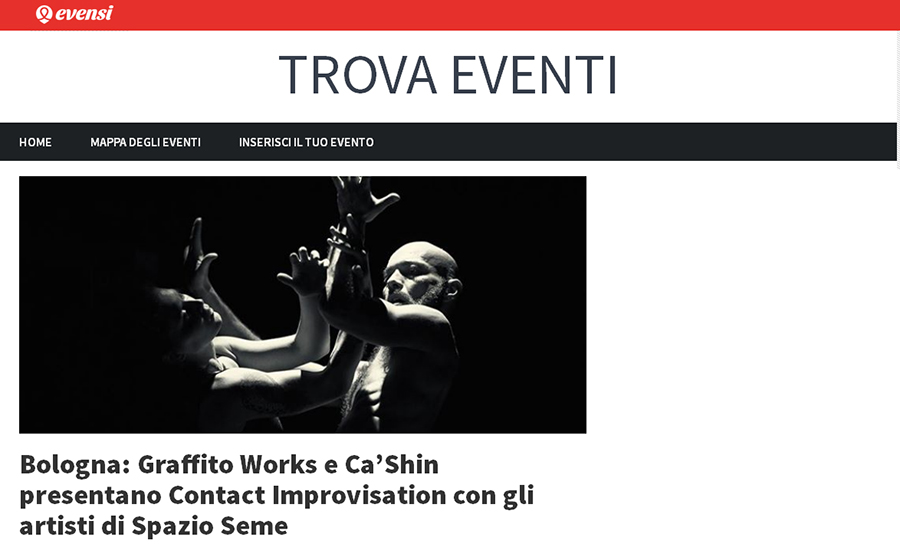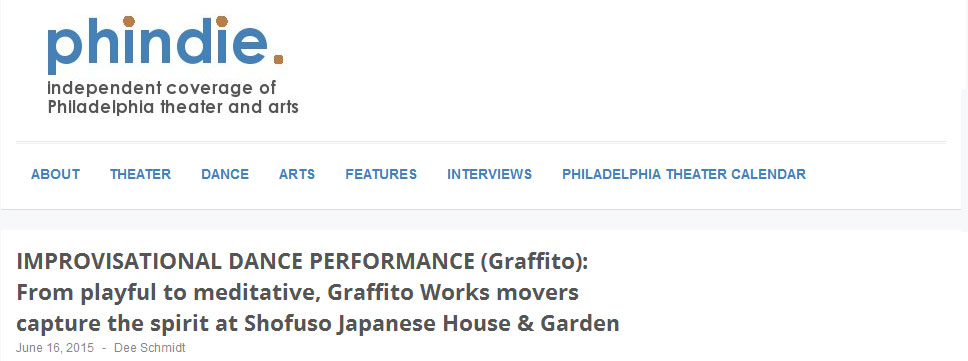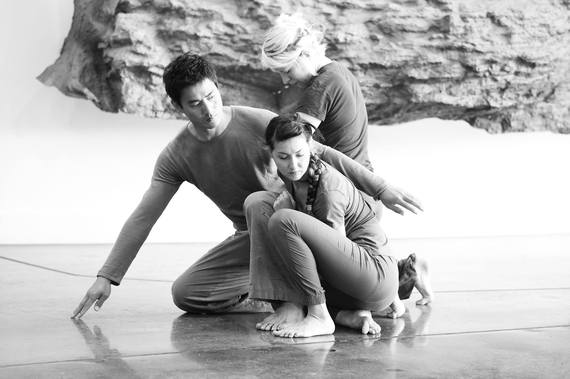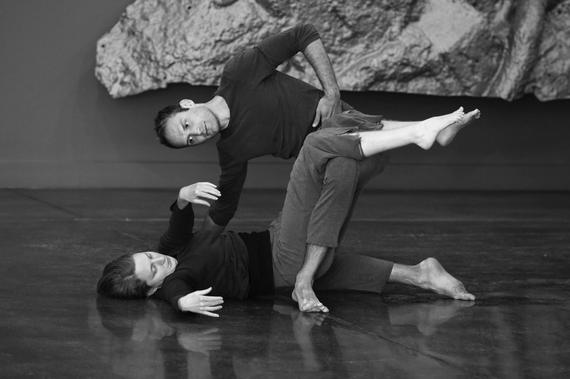EVENSI – Bologna: Graffito Works e Ca’Shin presentano Contact Improvisation con gli artisti di Spazio Seme
26 luglio 2015 presso Cà Shin a Bologna.
I pezzi creati nell’ambito di Graffito Work vengono mostrati in spazi non tradizionali, invitando i danzatori ad esplorare possibilita’ interpretative che vanno oltre le usuali convenzioni artistiche, e offrendo al pubblico dei pezzi rilevanti ed accessibili.
Lo spettacolo del 26 luglio centrera’ su movimenti di improvvisazione ispirati dal suggestivo parco che circonda Ca’ Shin. Questa produzione e’ il frutto d una collaborazione con gli artisti del centro Spazio Seme di Arezzo, con i quali Weisz ha collaborato nel 2012.
Weisz e’ stato ispirato dall’uso di contact improvisation dei danzatori di Spazio Seme. Weisz spiega che “gli artisti creano un dialogo con il pubblico fuori dal comune, un momento interpretative transitorio che condividono con i presenti ”. Questo e’ il tipo di esperienza che Weisz spera di offrire nel corso di future collaborazioni internazionali di Graffito Works. “ Danza, movimento e musica sono lingue universali, capaci di unificare culture e generazioni diverse, e che ci danno l’opportunita’ di condividere la nostra natura umana”.
Per Weisz, questa nuova collaborazione con gli artisti di Spazio Seme e’ un modo di offrire al pubblico di Bologna “ la semplice gioia del movimento e della natura umana” E con questo, spera che il pubblico sia toccato da questa esperienza.
Graffito Works
26 luglio, 2015 19:30
Ca’ Shin
via Cavaioni 1, Bologna
Lo spettacolo e’ gratuito
Per informazioni: [email protected] o Tel. 051 589419
Spazio Seme
Spazio Seme – arti in movimento è un centro artistico internazionale in cui si organizzano corsi e laboratori per adulti e bambini, si producono e ospitano spettacoli, concerti e mostre, così come eventi pubblici o privati. Seme s.n.c. è la società che lo gestisce, operando nel mondo della cultura, dell’arte e dello spettacolo ideando e favorendo occasioni di ricerca e di collaborazione fra diverse realtà italiane e internazionali. Spazio Seme è un luogo d’incontro fra varie “arti in movimento”, al di là delle lingue e delle differenze. Seme lo ha creato tre anni fa: 400 mq suddivisi in due ampie sale attrezzate, con bar interno, parcheggio privato e resede. Spazio Seme collabora con associazioni, fondazioni, enti pubblici e privati in iniziative e progetti internazionali.
Cà Shin
A Parco Cavaioni, a 10 minuti dal centro di Bologna, si trova Cà Shin, uno spazio pensato per grandi e bambini ideato e gestito dalla cooperativa sociale Le Ali. Cà Shin è un luogo di ristoro, biblioteca, teatrOrto, palestra, bosco e giardino. Salvaguardia, tutela, promozione culturale e ambientale sono le parole d’ordine. Un luogo che coniuga cibo sano, ambiente caldo e accogliente e una particolare attenzione all’arte, all’infanzia e all’ecologia. Cà Shin è un luogo dove prendersi del tempo ed avere ritmi più in sintonia con la natura, un luogo dove riscoprire il piacere di chiacchierare…. senza fretta.
———————————————————————————————————————-
USA-based Graffito Works artistic platform showcases Arezzo’s Spazio Seme ensemble at Ca’ Shin
Graffito Works will premiere in Italy on July 26th in Bologna’s Ca’Shin, located in the Parco Cavaioni compound, at 7:30 PM, showcasing the contact improvisation dancers of Spazio Seme, in Arezzo.
Graffito Works, literally translated as little scribbles of movement, is the brain child of Philadelphia based Steven Weisz founder of PhiladelphiaDANCE.org and the Dance Journal. Weisz has produced numerous dance programs across the United States as well as internationally. With Graffito Works, he has diverged from the traditional dance company structure, creating a new platform for dancers and performing artists. Work is created in non-traditional spaces, challenging the dancers to push the boundaries of their craft while making their work relevant and accessible to a wider audience.
The performance on July 26th will feature improvised movement that is inspired by the beautiful park surroundings at Ca’Shin. The performance is being produced in collaboration with dancers from Spazio Seme in Arezzo with whom Weisz has previously worked with when visiting in 2012.
Weisz had been influenced by the dancers at Spazio Seme and their use of contact improvisation in the creation of new work. According to Weisz, “it’s a different kind of experience, a transient moment in time, but also a shared experience”. It is this shared experience that he hopes to bring to more audiences in his travels. “Dance, movement and music are universal languages that bridge gaps between cultures and generations and allows us to share in our common humanity”.
For Weisz, returning to Italy and being able to produce work with the Spazio Seme dancers is a way to share “the sheer joy of movement and the human experience”. And he hopes that audiences will be “moved with us”.
Graffito Works
July 26th at 7:30pm
Ca’ Shin
via Cavaioni 1, Bologna
Free admission
For more information: [email protected] o Tel. 01139 051 589419
-30-
Spazio Seme
Spazio Seme was established in 2012 as a company specializing in the design, production and organization of events, courses, performances and workshops. Its founders include Leonardo Lambruschini, Francesco Botti, Gianni Bruschi, and Francesca Bassani, along with other collaborators. Spazio Seme’s mission is the facilitation of collaborative enterprises between Italian and internationally based performers. It has its base of operations in Arezzo, Italy. Spazio Seme works with associations, organizations, foundations and private initiatives to create opportunities for expressive research and dialogue with different cultures resulting in large-scale projects.
Cà Shin
A Cavaioni Park, 10 minutes from the center of Bologna, Cà Shin is a space designed for adults and children, conceived and managed by the social cooperative Le Ali. Cà Shin is a place for quite contemplation with a library, theater, gym, forest and garden. Preservation, protection and promotion of culture and the environment are key to its mission. Cà Shin offers farm to table food, a warm friendly atmosphere and a focus on art, child development and ecology. Cà Shin is a place where one can take time out and be more in tune with the rhythms of nature and rediscover the pleasure of life …. unhurried.
Indirizzo: via Cavaioni, 1, Bologna








